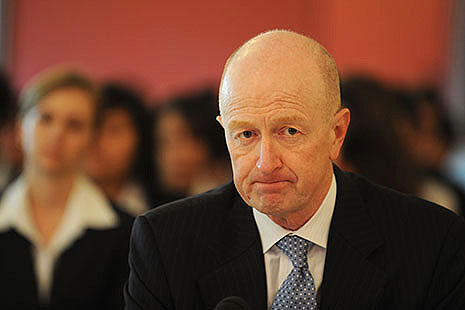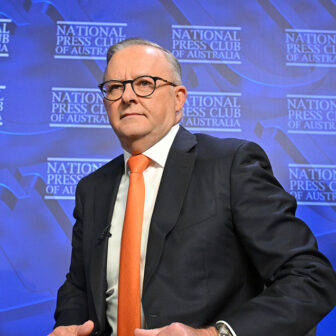AUSTRALIA is in the midst of the most remarkable resources boom in its history: both mining investment and the terms of trade are at record levels and investment is continuing to increase further. But the domestic economy is slowing: real GDP rose by only 1.4 per cent over the past year, while employment has been virtually flat in the first nine months of 2011, with unemployment rising a little. How can both of these things be happening at the same time? The answer to this question is of real importance for monetary and fiscal policy, which are both set to offset the expansionary effects of the resources boom. The continuing uncertainty about the world economy further clouds the issue.
The current mining boom has been reshaping Australia, and has made most of us much better off. Imports of all types are much cheaper, and the value of shares in superannuation portfolios has risen. But the boom also has negative effects, hitting trade-exposed industries such as manufacturing, tourism and education, and the communities and regions that depend on them.
For eight years, leaving aside the brief period of the global financial crisis, the mining boom has delivered increased net benefits each year. The Australian economy and its policy-makers have coasted along in the wake of these benefits. But now the situation has changed. While the boom continues, its net benefits have peaked. On a year-on-year basis it is no longer boosting growth in the Australian economy nor contributing to improved welfare for Australian citizens.
Australia must find new sources of growth, and adjust to a new reality of a high exchange rate but without further stimulus from mining. The boom has underwritten the economy for almost a decade. The new challenge is to shape policy in quite different circumstances for the next decade.
In the immediate future this will mean further interest rate cuts and a shift to a more expansionary fiscal policy. The once laudable goal of achieving a budget surplus in 2012–13 is now inappropriate. The federal government should move to a more expansionary fiscal policy rather than pursuing an outdated commitment for political reasons. But the longer-term challenges will be more complex.
Understanding the resources boom
Traditionally, Australia has been said to be experiencing a resources boom if either the level of resource investment as a share of GDP or the terms of trade (the ratio of export prices to import prices) were at high levels. In the current boom both variables are at record levels simultaneously, for the first time in Australia’s history. This means that the analysis of this unique episode is complex, with interweaving price and volume effects at work.
The net impact of the resources boom can be analysed as the overall effect of four key factors: (i) the impact of lower import prices on the real value of domestic incomes; (ii) the impact of higher $A export prices on the incomes and financial assets of Australian owners of resource companies; (iii) the impact on domestic economic activity and employment of the Australian content of resource investment; and (iv) the negative impact of the higher real exchange rate on trade-exposed sectors – such as manufacturing, tourism and educational services. While most focus has been on mining investment, the first of these has probably been the most important in macroeconomic terms.
In analysing the overall impact of the boom it is also necessary to distinguish between level and change effects. The level effect has been building over eight years, with an increasing impact each year except for the period of the global financial crisis. But the incremental effect – the change in the impact from year to year – is more important for policy formulation, and it is widely assumed that the boom will have a continuing positive incremental impact on the economy in the years ahead. By contrast, it seems that the net incremental effect has now peaked – the level effect, while still positive, is no longer increasing.
The reason for this change is that the positive effects of the boom have ceased or become more muted, while the negative effects are becoming more pronounced.
First, the rise in the exchange rate has boosted the real incomes of all Australians who use imported goods and services, as we all now do to varying degrees. We can buy more imported cars, foodstuffs, electrical and electronic goods and overseas trips, or save on our spending on imports and use the money elsewhere. As a result of these and other factors real household income per capita increased by 2.8 per cent per annum over 2002–11, nearly three times the rate of the previous twenty years. It 2011 it is about 18 per cent higher than it would have been had the earlier trend prevailed. But the sharp rise in the exchange rate has come to an end, as has real income growth from this source.
Secondly, the mining boom is so massive that, even though the sector is now about 80 per cent foreign owned, the rise in mining incomes has flowed through to the value of assets held by many Australians. Reflecting this and other factors, between 2002 and 2007 the real per capita assets of Australian households increased by 8 per cent per annum, about three times the long run rate. But this source of benefit has also come to an end. Share prices are well below their earlier peak, real house prices are falling and many of the biggest new mining projects are effectively 100 per cent foreign owned.
Thirdly, mining investment continues to increase, and the Reserve Bank predicts that it could reach 7 per cent by 2013–14. But what matters for the stimulus is the local content of this huge investment, which appears to be falling quite sharply. The emphasis is shifting to large LNG projects, often offshore, and the high $A is reducing the competitiveness of Australian suppliers.
An extreme case of the shift in composition is the $12 billion Prelude LNG project, being built by Shell for drilling offshore in Western Australia. This involves the construction in Korea of a platform three times the size of the MCG, which will contain the drilling rig, the liquefaction plant and docking facilities. It will be towed to the gas location and all aspects of production and export will be undertaken at that location. The local content implications of such a project are minimal indeed.
Finally, as the Australian dollar stabilises at or above parity with the US dollar the position of trade-exposed local industries is becoming more difficult. Producers and customers do not respond much to volatility in the exchange rate. But when a major change becomes entrenched more serious decisions are made to change the source of supply or spending. This is most evident in manufacturing, tourism and international education.
Implications for policy
Monetary policy has been “mildly restrictive,” in the words of the Reserve Bank, for some time now, being directed to offset the presumed incremental expansionary impact of the resources boom and by concern about inflation running above the target band. Neither of these concerns are still relevant, the first for the reasons outlined above and the second because it is clear that there is now no inflationary problem in Australia that needs to be addressed by a restrictive monetary policy.
Over the three years to the June quarter of 2011, five sub-groups, out of a total of ninety in the CPI and accounting for about 12 per cent of the index, have provided 40 per cent of the growth in the CPI, and 44 per cent of the growth over the past year. The five groups are lamb and mutton, fruit, vegetables, utilities and tobacco. These five groups in total have risen by 11.9 per cent per annum over the past three years, while the rest of the CPI rose by 1.8 per cent; over the past year the five groups rose by 16.7 per cent and the rest of the index by 2.2 per cent. Excluding these items, inflation has been well within the Reserve Bank’s target range of 2–3 per cent on average over the cycle.
There is no reason for thinking that the rapid growth in prices for these items can be significantly influenced by monetary policy. Prices for the food items reflect seasonal supply conditions, while increases in tobacco prices are driven by regular increases in tax rates. The reasons for the rapid growth of utility charges (11.5 per cent per annum over three years) are far from clear, but it is unlikely that price changes for this group would be greatly affected by a restrictive monetary policy. On 1 November 2011 the Bank recognised that the economy was slowing and the threat of inflation was easing, and cut interest rates accordingly, moving to a more neutral stance.
Fiscal policy is currently severely rather than mildly restrictive, with the federal government overseeing the most rapid process of fiscal consolidation for over forty years. In the context of a perceived powerful continuing stimulus from the resources boom and in pursuit of a balanced budget by 2012–13, the government proposes to take $50 billion or 3.6 per cent of GDP out of the economy (on an underlying cash basis) over 2011–12 and 2012–13. Again, neither of these concerns is currently relevant to Australia’s economic situation. Partly reflecting the considerations outlined above and ongoing issues in the European Union and the United States, the outlook for the Australian economy is now much weaker than that presented in May in the 2011–12 Budget Papers, in spite of the continuing resources boom. Real GDP has grown by 1.9 per cent per annum over the last three years, and GDP growth for 2011–12 in now likely to be closer to that figure than to the forecast 4 per cent, while employment growth will fall well short of the 1.75 per cent forecast.
Australia’s fiscal position is very strong, with Australian government net debt at only 6.1 per cent of GDP at the end of 2010–11. It will be strengthened further over the next decade, even under the current taxation regime, as tax revenue from higher resource prices and from projects currently under construction begins to flow in. This revenue has been delayed by capital losses incurred in the global financial crisis and by depreciation allowances being generated by high levels of capital investment. The scale of both the investment and the depreciation allowances being generated is massive, but tax revenues from the resources sector will rise strongly when these allowances are used up.
It is no longer appropriate for the government to pursue a budget surplus in 2012–13. It should move away from this target and adopt a much less restrictive fiscal policy, more supportive of economic growth. Unfortunately the government continues to reiterate its commitment to this target, and has foreshadowed further cuts to this end in the context of the Mid-Year Economic and Fiscal Outlook to be released before the end of the year. This could prove to be a serious mistake, based on political rather than economic judgements. •




